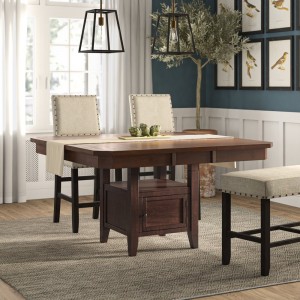The dining table - a gathering hub, a focal point and the heart of the home, it’s crucial that you pick one that fits the space, enhances the aesthetics and suits your budget.
Kitchen and dining tables have evolved into this protean, utilitarian surface that’s burdened with a multitude of responsibilities these days. It is where your guests will gather, come an impromptu weekend do. It is where the kids will come together to finish their arts projects. It is also where you will sit, with family, often for hours, sharing laughs and contemplating about the days to come.
If this is your first attempt at shopping for kitchen and dining tables, then it can be a tad overwhelming. Here’s some help.
How big a dining table should I get?
Irrespective of whether you have a formal dining room to place the table in, or you are just squeezing out some space between the living room and your open kitchen, measuring the space is the first step to ensure balance and harmony.
- The dining table needs to fit in the space without being too cramped or the other way round, too small.
- If it’s too cramped, it will make the space look overwhelming.
- If it’s too small, the space will look empty. Contrary to popular believe, no amount of carts will fill the void.
- Even if you are a family of three, go for a table for five or six people if you have the room.
How do you decide whether there’s enough space? Here are some numbers to use as a reference point.
- Each person at the table needs at least 25-30″ of room to eat comfortably without elbows bumping into each other.
- In addition to this, you need at least 3 feet of wall/furniture clearance on all sides, so that you and your guests can get in and out of the chairs comfortably.
- Anything lesser than this and it would be too tight a fit for the available space.
What’s the right shape for my dining table?
Square and rectangular tables
- Square and rectangular tables are generally suited for large, long spaces. That doesn’t mean that you cannot place a square table in a narrow space. It’s just that it would make it very difficult to comfortably move around the table for serving. Ditto with rectangular tables which have demanding footprints.
- If you have your mind set on a square or rectangular table, a workaround is to use a bench instead of chairs. This way, you can tuck it under the table when it’s not in use, saving space.
- You can also opt for** a drop leaf design** which can be folded when not in use.
- The advantage od rectangular tables is that there is an abundance of styles to pick from, in both square and rectangular tables.
- A lot of home owners match the shape of the table to the room. Square tables for square rooms and rectangular ones for long, narrow rooms.
Round and oval tables
- Round and oval tables are better suited for smaller spaces as they maximize the utility of every inch of available space.
- There are no corners.
- Round and oval tables have smaller footprints, particularly pedestal-styled ones and can be placed just about anywhere without looking like a misfit. Be it a tiny nook or a large open-eating area, they blend right in.
- The caveat is that the larger the round table, the more difficult it will be to reach out and grab that bowl of mashed potatoes. Adding a lazy susan to the center will put things right within your reach.
Pro tip: Analyze visually before deciding
If you aren’t able to decide on a shape and size, here’s a possible way to wrap your head around it.
- Mark the area that you have earmarked for the kitchen and dining table with painter’s tape. To get an idea of the height, fill that area with similar-sized furniture pieces. Chairs, for example.
- Grab a bedsheet or two if need be and fold it to the size and shape of the table. This way you will know the exact amount of space it needs and also how it will look in the surroundings.
What are the advantages of different dining table materials?
Aesthetics and dimensions apart, the table needs to be as sturdy as a rock, easy to maintain and suited to the space around it. It’s vital to pick the right material and texture.
Your options are manifold.
Wood
Classic, infallible material available in almost every style of furnishing. Surprisingly low on maintenance, extremely durable and easy to fix if it does get damaged. Solid hardwood like Oak, Maple, Walnut and Mahogany are top of the line, followed by less expensive varieties like Mango, teak and Pine. If you have a limited budget, then you can consider wood veneer, which mimics the look of solid wood at a fraction of the cost.
Post time: Aug-16-2022



